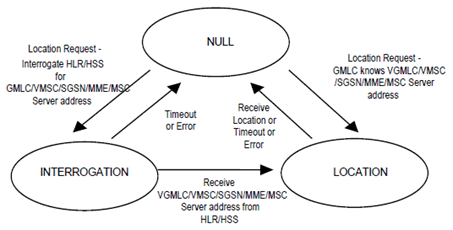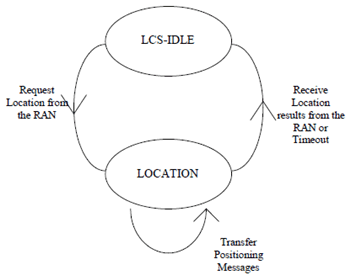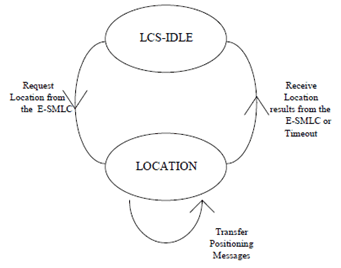Content for TS 23.271 Word version: 18.0.0
1…
5…
6…
6.2…
7…
8…
9…
9.1.1A…
9.1.2…
9.1.5…
9.1.6…
9.1.8…
9.1.9…
9.1.12…
9.1.13…
9.1.15…
9.1.19…
9.2…
9.2.2…
9.2.3…
9.3…
9.4…
9.5…
9.6…
10…
11…
A…
B…
E
F…
8 General network location procedures
8.1 State description for GMLC
8.2 State description for VMSC and MSC Server
8.3 LCS State description for SGSN
8.4 Signalling connection for the Iu interface
8.5 Signalling connection for the A-interface
8.6 Gb interface mapping of target UE
8.7 LCS State description for MME
8.8 Signalling connection for the S1 interface
...
...
8 General network location procedures p. 51
8.1 State description for GMLC p. 51
8.1.1 GMLC states p. 51
8.1.1.1 NULL State p. 51
In the NULL state, a particular location request from some LCS client either has not been received yet or has already been completed. After a location request is received from a LCS client, the GMLC remains in the NULL state while the identity of the client and nature of its location request are verified. While the NULL state exists conceptually, it need not be represented explicitly in the GMLC.
8.1.1.2 INTERROGATION State p. 52
In this state, the GMLC has sent an interrogation to the home HLR/HSS of the UE to be located and is awaiting a response giving one or several of the following addresses: the VMSC, MSC Server, SGSN address, MME address and IMSI for this UE.
8.1.1.3 LOCATION State p. 52
In this state, the GMLC has sent a location request to the VMSC, MSC Server, SGSN or MME serving the UE to be located and is awaiting a response containing a location estimate. Optionally, location information may also be communicated between GMLCs, located in the same or a different PLMN, via the GMLC to GMLC Lr interface
8.1.2 State functionality p. 52
8.1.2.1 State Transitions p. 52

Moving from NULL to INTERROGATION state:
If the GMLC does not know any of the following addresses: VMSC, MSC Server, SGSN, MME, V-GMLC address or IMSI when it receives a location service request from some LCS client, it moves from the NULL state to the INTERROGATION state and sends a request to the UE's home HLR/HSS for the VMSC/ MSC Server/ SGSN /MME/ V-GMLC address and IMSI.
Moving from NULL to LOCATION state:
If the GMLC already knows one of the following addresses: VMSC, MSC Server, SGSN, MME or UE IMSI, when it receives a location service request from some LCS client (e.g. from information retained for an earlier location request for the same UE), it moves from the NULL state to the LOCATION state and sends a location request to either the VMSC, MSC Server, SGSN, or MME. Optionally, it may send the location request to another GMLC via the Lr interface.
Moving from INTERROGATION to LOCATION state:
After the GMLC, in the INTERROGATION state, receives one or several of the addresses VMSC, MSC Server, SGSN, MME, V-GMLC and IMSI from the home HLR/HSS, it enters the LOCATION state and sends a location request to either the VMSC, MSC Server, SGSN, MME or V-GMLC of the UE being located.
Moving from LOCATION to NULL state:
After the GMLC receives a location estimate response from the VMSC, MSC Server, SGSN, MME or V_GMLC, it forwards the location estimate to the requesting LCS client and re-enters the NULL state.
8.1.2.2 INTERROGATION Timer Function p. 53
The GMLC runs a timer while in the INTERROGATION state to limit the amount of time waiting for an interrogation response from the HLR/HSS. If the timer expires before an interrogation response is received, the GMLC indicates a location failure to the LCS client and re-enters the NULL state.
8.1.2.3 LOCATION Timer Function p. 53
The GMLC runs a timer while in the LOCATION state to limit the amount of time waiting for a location estimate response from the VMSC/ MSC Server /SGSN/MME. If the timer expires before a response is received, the GMLC indicates a location failure to the LCS client and re-enters the NULL state.
8.2 State description for VMSC and MSC Server p. 53
8.2.1 VMSC and MSC Server States p. 53
8.2.1.1 LCS IDLE State p. 53
In this state, the VMSC/MSC Server location service is inactive for a particular UE. The UE may be known in the VMSC/MSC Server (except for a USIM less or SIM less Emergency call or where the UE information has been cancelled or lost in the VMSC/MSC Server), but there may not be an active Mobility Management to the UE.
8.2.1.2 LOCATION State p. 53
In this state, the VMSC/MSC Server is awaiting a response from RAN after requesting the location for a particular UE.
8.2.2 State Functionality p. 53
8.2.2.1 State Transitions p. 53

Moving from LCS IDLE to LOCATION state:
After a request has been received to locate a particular UE and the UE subscription options have been verified, a location request is sent to the RAN of the UE to be located: the VMSC/MSC Server then enters the LOCATION state. Before entering this state, the VMSC/MSC Server must have setup a Mobility Management connection to the UE if none was previously active. The mobile is paged and authenticated before positioning.
Moving from LOCATION to LCS IDLE state:
After the return of a location estimate result from RAN, the VMSC/MSC Server shall re-enter IDLE state.
8.2.2.2 LOCATION Timer Function p. 54
The VMSC/MSC Server runs a timer while in the LOCATION state to limit the amount of time waiting for a location response from the RAN. If the timer expires before such information is received, the VMSC/MSC Server indicates a location failure to the original requesting entity and re-enters IDLE state.
8.3 LCS State description for SGSN p. 54
8.3.1 SGSN States p. 54
8.3.1.1 LCS IDLE State p. 54
In this state, the SGSN location service is inactive for a particular UE. The UE is known in the SGSN except in case where the UE data has been cancelled or lost in the SGSN. There is not an active Mobility Management to the UE.
8.3.1.2 LOCATION State p. 54
In this state, the SGSN is awaiting a response from the RAN after requesting the location for a particular UE. In this state, a Mobility Management connection to the target UE will be active.
8.3.2 State Functionality p. 54
8.3.2.1 State Transitions p. 54

Moving from LCS-IDLE to LOCATION state:
After a request has been received to locate a particular UE and the UE subscription options have been verified to allow this, the SGSN sends a location request to the RAN. The SGSN then enters the LOCATION state. Before entering this state, the SGSN must have setup a Mobility Management connection to the UE if none was previously active. The mobile is paged and authenticated before positioning.
Moving from LOCATION to LCS IDLE state:
After the return of a location estimate result from RAN, or if the Location Timer described below expires, the SGSN shall re-enter IDLE state.
8.3.2.2 LOCATION Timer Function p. 55
The SGSN runs a timer while in the LOCATION state to limit the amount of time waiting for a location response from the RAN. If the timer expires before such information is received, the SGSN indicates a location failure to the original requesting entity and re-enters IDLE state.
8.4 Signalling connection for the Iu interface p. 55
When using the Iu interface, before SGSN/MSC server can request location information of a target UE from RAN, an Iu signalling connection must have been established between SGSN/MSC server and RAN. The SGSN/MSC server sends a location request message to RAN, which determines the location of the target UE related to this Iu signalling connection and sends a location report to SGSN/MSC server over the same Iu signalling connection. On the Iu interface, only one location request for a geographic location estimate can be ongoing at any time.
8.5 Signalling connection for the A-interface p. 55
When using the A interface, before MSC can request location information of a target UE from RAN, an A interface signalling connection must have been established between MSC and RAN. The MSC sends a location request message to RAN, which determines the location of the target UE related to this A interface signalling connection and sends a location report to MSC over the same A interface signalling connection. On the A interface, only one location request can be ongoing at any time.
8.6 Gb interface mapping of target UE |R5| p. 55
The pre-requisite for LCS procedures on the Gb interface is that UE is in "ready state". On the Gb interface, only one location request can be ongoing at any time.
8.7 LCS State description for MME |R9| p. 55
8.7.1 MME States p. 55
An MME supports at least one location session for any UE at any one time. A location session is invoked by the MME in order to obtain the location of the UE or perform some other location related service such as transferring assistance data to the UE.
8.7.1.1 LCS IDLE State p. 55
In this state, the MME location service is inactive for a particular UE. The UE is known in the MME and a mobility management connection for the UE may or may not be active.
8.7.1.2 LOCATION State p. 55
In this state, the MME is awaiting a response from an E-SMLC after requesting a location service for a particular UE. In this state, the UE is known in the MME and a Mobility Management connection to the UE is active.
8.7.2 State Functionality p. 56
8.7.2.1 State Transitions p. 56

Moving from LCS-IDLE to LOCATION state:
After a request has been received for a particular location service for a particular UE and the UE subscription options have been verified where applicable to allow this, the MME sends a location request to an E-SMLC. The MME then enters the LOCATION state. Before entering this state, the MME must have setup a Mobility Management connection to the UE if none was previously active.
Moving from LOCATION to LCS IDLE state:
After the return of a location result from the E-SMLC, or if the Location Timer described below expires, the MME shall re-enter IDLE state.
8.7.2.2 LOCATION Timer Function p. 56
The MME runs a timer while in the LOCATION state, whose value may depend on the location service, to limit the amount of time waiting for a location response from the E-SMLC. If the timer expires before such information is received, the MME indicates a location failure to the original requesting entity and re-enters IDLE state.
8.8 Signalling connection for the S1 interface |R9| p. 56
Before the MME can request location information of a target UE from the E-SMLC, an S1 signalling connection must have been established between the MME and E-UTRAN. The MME sends a location request message to E-SMLC, which determines the location of the target UE related to this S1 signalling connection and sends a location measurement report to the MME.